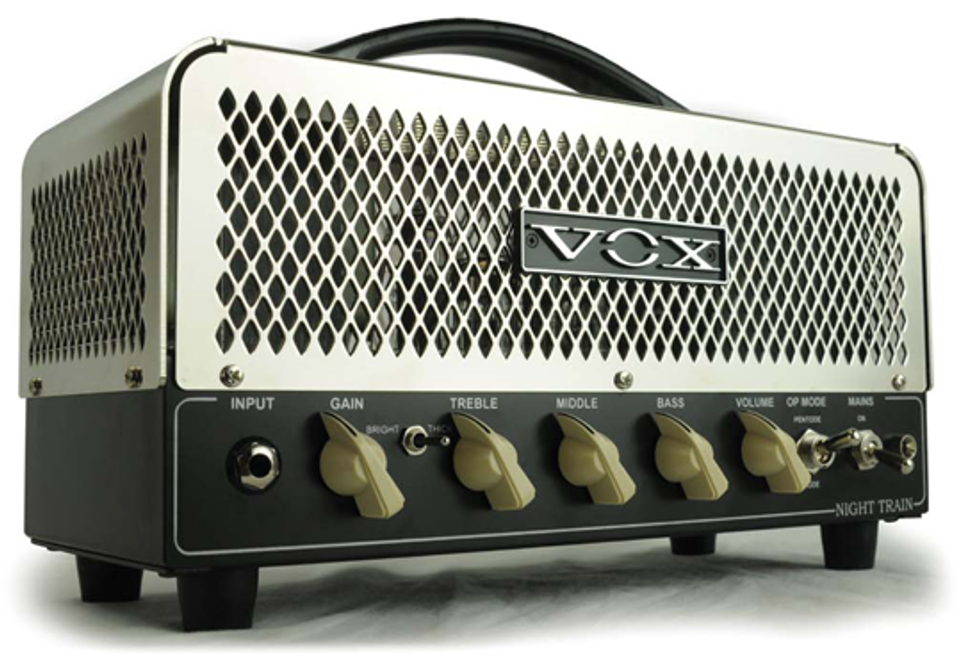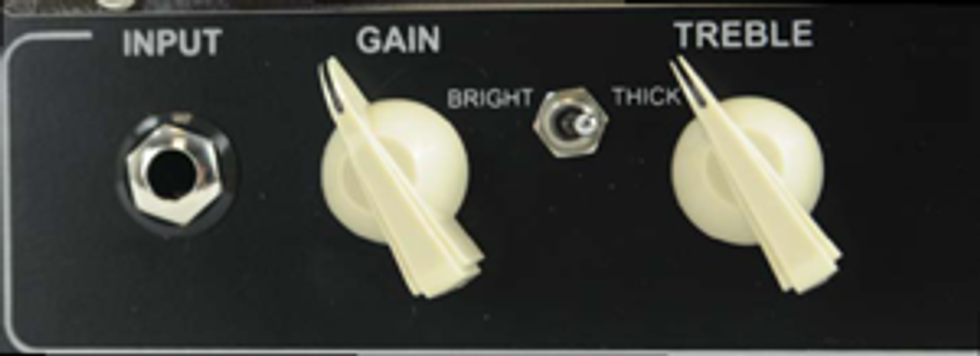In every aspect of technology in the current age, it seems as if miniaturization and portability is all the rage. Cellular telephones, television sets, computers and (as we all know by now) guitar amplification have all been caught up in the trend toward packing more and more features into ever-shrinking containers. In the case of the Night Train, VOX Amplification’s newest addition to their guitar amp line, the design considers technologies that lie both in the past and present, merging both into a deceptively potent tone machine. A dual-EL84 tube power section coupled with a dual-12AX7 preamp allows the Night Train to pump out either 15 or 7.5 watts from its retro toaster-sized packaging.

| Watch the video review: Click here to watch it full-size |
At first glance, the Night Train seems like a less-than-imposing creation. Its small, compact design sits at just a little over a foot wide, and it’s dwarfed by any cabinet larger than a standard 1x12” (like the V112NT, VOX’s companion for the Night Train with a custom-voiced Celestion Greenback speaker). The construction quality is extremely solid: the chassis is a combination of brushed and mirror-finished steel, weighing in at slightly less than 17 pounds. Thankfully, VOX didn’t cut any corners with building materials, as the only plastic parts that are exposed are the classy, off-white chickenhead knobs that adorn the faceplate. The thing I noticed about the Night Train right away is how streamlined the build is. All of the screws joining the chassis together are recessed, and the corners are slightly rolled. This might not seem like a big deal to some, but it really shows the attention to detail and presentation that it’s designers put into the head. VOX describes it as an “armored lunchbox,” and the solid, smooth design helps ease worries of dropping the amplifier on an exposed foot or off the edge of a stage. In addition, it just looks really cool, like a space-age toaster of the future that a 1950s sci-fi writer would dream of. Transportability was a major factor in designing the Night Train, so VOX also included a sturdy, padded carrying-case with a shoulder strap for taking the amp to jams and recording sessions.
Flyin’ like an aero plane
Eager to hear VOX’s new creation, I plugged in a 2008 Fender Telecaster and set up the head with an Egnater 1x12” cab with a Celestion Vintage 30. Following some careful dialing, a very nice clean with a surprisingly chimey top end poured out of the speaker. The front panel of the amplifier has a simple, comfortable layout consisting of Gain, three-band EQ, and Volume controls. Nestled between the Gain and Treble knobs is a switch labeled Bright/ Thick, which produces a highly perceptible difference in the voicing of the amp. Roundingout the controls is the Standby switch, which also functions as a wattage selector.
According to Dave Clarke of Vox R&D, the preamp was inspired by one of his favorite amplifiers: the Trainwreck Express, designed by Ken Fischer. Apart from its legendary sound, the Trainwreck Express was produced in very small numbers and is extremely hard to find, commanding tens of thousands of dollars in some cases. The Night Train’s power section was born from concepts introduced by the AC15CC, and various component changes and tweaks were thrown in to give the Night Train its own, unique voice amongst its British siblings. In the up position (Pentode), the Night Train runs at 15 watts, and the down position (Triode), the head drops the wattage down to a modest 7.5 watts.
 Speedin’ like a space brain
Speedin’ like a space brain I put the Night Train in Pentode mode, with the Gain barely above the 9 o’clock position, tone controls at noon, and the tone switch selected to Bright. Most small-wattage heads have an issue with clean headroom, but the Night Train is certainly an exception. Pushing the master volume just made it louder and punchier, and only when I used a really strong pick attack was there any sort of dirt on edges. Moreover, it was surprising how easy it was to get this loud, tight clean tone out of the tiny, gleaming wonder sitting in front of me. The newfound excitement lead me to trying a more diverse array of instruments with this clean sound, just to see if I could get the amp to give without having to perform any major adjustments. While the Gibson Les Paul Custom, Duesenberg MC Signature and Fender USA Stratocaster all had obviously varying tones, the Night Train still kept its sterling high end and authoritative punch. It would be interesting as well to see how this channel would react with a 12AT7 in the first position, instead of the standard high-gain 12AX7 that it ships with. The Night Train also seems to respond a little better to single-coil pickups, especially Tele-style ones. With humbuckers, the tone is wider, but seems to lose a little bit of focus when pushed to higher gain and volume modes, whereas the Tele’s bridge pickup stayed twangy and detailed at almost all levels.
The Night Train’s high-gain tones are, in the best possible terms, a completely different animal. While the Bright mode is capable of creating smooth, clear overdrive, the Thick mode turns the jangly Night Train into a roaring fiend. Designed in conjunction with famed amp designer Tony Bruno, the Bright/Thick switch isn’t really a dedicated tonal change, but seems more like a channel switch. Using the Les Paul Custom and flipping the switch to Thick, the amp shook off and shed the classic ‘60s vibe that I’d been enjoying. It snarled with an incredible Slash-esque bark. There is a very conspicuous volume increase with the switch set in this position, but in a good way. The Night Train breathes a bit better, and pushes more air. It was really strange standing in front of this little mini-stack and feeling like it was kicking me in the shins like a child in a temper tantrum.
I moved the head to a Bogner 4x12” with Celestion Vintage 30s, which allowed it to really showcase how multidimensional the overdrive tones are, unlike some small-wattage heads with rather flat and dull distortion sounds. Despite being a 15-watt amplifier, the Night Train is very loud and powerful, but can get noisy when pushed hard. Feedback was a big issue at high volumes with both the Les Paul and a Paul Reed Smith Starla, both of which were equipped with humbuckers. Some of the sweetest lead tones the Night Train can produce come from pushing the power section, so liberal use of the guitar’s volume knob is recommended to avoid any sort of auditory chaos that might ensue. Lowering the gain knob helped, of course, and some very cool non-master volume types of tones are possible using the Gain knob as the master while the Master Volume is at 3 o’clock or higher.
The most exciting moments with the Night Train for me were using the extremely satisfying clean channel. It’s not often that you find a small-wattage head with cleans that can compete tonally with some of its larger wattage brethren, and also be as capable and convenient for gigging (provided that the drummer isn’t playing too loud). It’s certainly the best sounding small-wattage clean tone that I’ve heard so far.
The Final Mojo
Coupled with a fantastic overdrive that seems like an entirely different amp itself, the Night Train is really hard to beat if you’re in the market for a low-wattage amplifier. Other than a little unruliness in higher volume situations, my only qualm in the design is the omission of an effects loop, or some other avenue for adding reverb and delay. Obviously a good-sounding reverb tank would be nearly impossible to fit in the tiny chassis, and a loop would handle this immediately. Hopefully future incarnations of the Night Train will include this feature, and (I’m crossing my fingers) make the Bright/Thick feature footswitchable. VOX has really hit it out of the ballpark with this one.
Buy if...
you want very smooth, controllable and usable cleans and great drive tones for recording small, intimate venues.
Skip if...
you need more than 15 watts, or an effects loop.
Rating...











![Rig Rundown: Russian Circles’ Mike Sullivan [2025]](https://www.premierguitar.com/media-library/youtube.jpg?id=62303631&width=1245&height=700&quality=70&coordinates=0%2C0%2C0%2C0)








